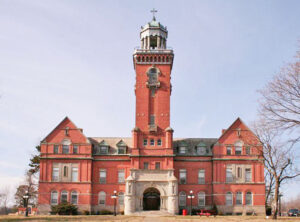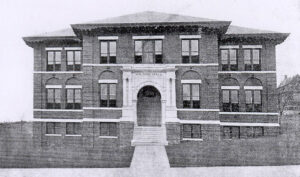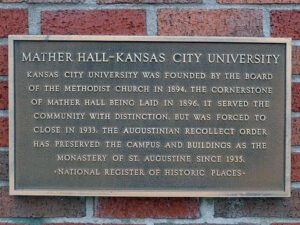Kansas City University was a private Methodist university in Kansas City, Kansas that was founded in 1896.
The school owed its existence to Dr. Samuel Fielding Mather, a descendent of Cotton Mather, a Puritan clergyman and author in colonial New England who was involved in the Salem witch trials of 1692–1693 in Massachusetts.
About a year before his death, he made a proposition to a board of trustees, appointed by the general conference of the Methodist Protestant Church, to convey to this board certain valuable tracts of land in the suburbs of Kansas City, providing a building or buildings should be erected before October 15, 1896, for $30,000. The offer was accepted on the last day of May 1895, just a few hours before Dr. Mather died. His will gave the residue of his estate to the contemplated college, provided the board of trustees fulfilled their part of the agreement.
On September 23, 1896, Mather Hall, a large brick-and-mortar building that held the school’s library, administrative offices, and numerous classrooms, was opened to students.
The university comprised seven departments, each having its own faculty, with courses of study leading to appropriate degrees. These schools were Mather College, School of Theology, College of Music, Kansas City Normal School, Wilson High School, School of Elocution and Oratory, and Kansas City Hahnemann Medical College. Mather College was situated on the university grounds in the suburbs of Kansas City.
In 1906, newspapers noted that the college president, D. S. Stephens, spoke in favor of a controversial merger between the United Brethren and Methodist Church conferences.
Wilson High School occupied a new building erected in 1907 for $25,000. It offered six courses of study, including classical, philosophical, and scientific courses, which admitted students to the college; an English course, a teacher’s course, and a business course were provided for students not expecting to attend college. The College of Elocution and Oratory presented facilities for instruction in the art of speaking in Kansas City, Missouri. The Hahnemann Medical College, also in Kansas City, Missouri, had existed for about 20 years and offered courses leading to the degrees of M.D., B.S., and Ph. D.
In 1910, there were three buildings, and plans were made to erect three more. H.J. Heinz, the pickle millionaire of Pittsburg, Pennsylvania, contributed $10,000 toward a dormitory to memorialize his wife. The university’s business affairs were under the management of 24 trustees who elected an endowment board of 16 people who had charge of the invested funds. The course of study in the college led to a Bachelor of Arts degree and was open to both men and women.
The catalogue for 1910-11 gave the following enrollment: Mather College 30, Wilson High School 149, School of Oratory 198, Normal School 10, Hahnemann Medical College 68, School of Theology 13; those counted twice 23, making a total of 435 students.
In 1913, Campbell College of Holton, Kansas, under the control of the United Brethren in Christ Church, merged with Kansas City University. The two religious denominations jointly operated the school until 1926, when the Methodists withdrew and the United Brethren bought out their interest. The final years of the school’s operation were difficult; in 1930, the United Brethren Board of Education decided to drop all support for the school.
In 1932, the mortgage against the school was foreclosed, and the property was sold to the Augustinian Order of the Catholic Church. Mather Hall then became St. Augustine Hall.
Some alterations were made after the building changed ownership, and in the late 1930s, a west wing was added.
It was listed on the National Register in February 1971 for its Eclectic period of architecture in Kansas. It has a classic colonnade tower form, rounded windows, and a layered facade.
Today, St. Augustine Hall is owned by the Central States Conference of the Seventh-day Adventist Church, which uses the building as a conference and retreat center.
It is located at 3301 Parallel Avenue in Kansas City, Kansas. As you enter the property at the southwest corner of Parallel Parkway and 33rd Street, a historic plaque is on the right gatepost.
Kathy Alexander/Legends of Kansas, updated December 2023.
Also See:
Historic Sites of Kansas
Past Colleges & Universities of Kansas
Sources:
Blackmar, Frank W.; Kansas: A Cyclopedia of State History, Vol I; Standard Publishing Company, Chicago, IL 1912.
Historic Marker Database
National Register Nomination
Wikipedia




